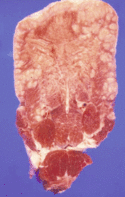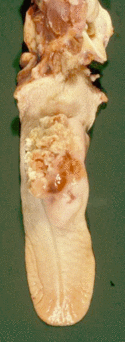Category:Tongue - Pathology
Jump to navigation
Jump to search
Introduction
See anatomy and physiology of the tongue
Erosive & Ulcerative Pathology
Ulcerative glossitis
Vesicular Pathology
Neutrophilic Inflammation
Liquefactive necrosis
- Introduction of pyogenic bacteria through the protective epithelium can lead to the development of localised liquefactive necrosis (abscesses) anywhere in the soft tissues of the oropharynx.
- These usually follow local trauma, e.g. penetrating foreign bodies.
- The bacteria involved are usually Staphylococci, Streptococci or Arcanobacterium pyogenes.
Granulomatous and pyogranulomatous Inflammation
Actinobacillosis
- "Wooden tongue"
- In cattle - very widespread in world, but rather sporadic, less common now than it was.
Clinical
- Seen in youngish animals in beef breed, especially sucklers on poor forage.
- Starts like foot and mouth disease - dull, salivating (if only one animal is unlikely to foot and mouth). - nearly always sporadic.
- ongue feels like a big lump of wood especially dorsal part of posterior 2/3rds.
- Small areas of ulceration are often found on side of tongue.
Pathogenesis
- Very similar to Mandibular Osteomyelitis ("lumpy jaw").
- Causal agent: Actinobacillus lignieresii (small gram -ve) gets into tongue via small abrasions.
- Pathogen is very widespread in environment.
- Progressive disease - low virulence but high persistence so animal may stop eating and eventually die but can be treated.
Pathology
- If cut into tongue, substance of tongue changed to fibrous stroma with raised red nodules. (2-3mm across).
- This lesion is a pyogenic granuloma with central sulphur body.
- Can spread from tongue to other tissues e.g. retropharyngeal lymph nodes and palate.
- This type of lesion is caused by the host response to the pathogen, rather than directly a pathogen effect.
Other sites
- Occasionally can see generalised infections but more commonly spreads to local lymph nodes of alimentary tract.
- Organism can be inhaled causing actinobacillus pneumonia.
- Can affect rumen wall.
- In skin forms a neoplastic like mass in dermis.
Eosinophilic Inflammation
Fibrinous/Diptheritic Inflammation
- Severe damage to epithelium produces exudation of fibrin -with formation of dry white fibrinous deposit - diptheritic membrane.
- Usually associated with organism fusobacterium necrophorum found everywhere in environment (but strict anaerobe).
- Produces lesions that damage epithelium due to toxin that damages vessels.
- Often a secondary invader but can be a primary pathogen.
Calf diptheria
- Caused by Fusiformis.
Clinical
- Seen in animals kept in cold, damp, muddy conditions.
- Usually associated with poor general health.
- Animals usually less than 6 months old, in groups and poorly kept.
- Lesions affect tongue, inside of mouth and larynx.
- Usually die fairly acutely as exudate blocks airway.
- May occur in young lambs secondary to orf (parapox) virus infection that can spread from lips to the inside of the mouth.
- (These lesions then become secondarily infected with Fusiformis.)
- Involvement of the pharynx and larynx may result in dyspnoea and the development of pneumonia.
- May lead to death.
Macroscopically
- Grossly, there is a firm swelling visible on the outer aspect of the cheek
- On the mucosal surface there is a deep, irregular ulcer, covered by a thick diphtheritic membrane.
Microscopically
- There is complete loss of the surface epithelium:
- a mass of necrotic debris
- polymorphs and fibrin is found overlying severely inflamed subepithelial tissues in which bacterial colonies may be seen and around which there may be marked fibrosis in an attempt to “wall off” the lesion.
Haemorrhagic Inflammation
- Complete loss of integrity of epithelium. Uncommon.
- Characteristic of “Blue Tongue”, a Reovirus infection of sheep - (v. rare – doesn’t occur in UK !).
- Epithelium lost and haemorrhage produces blue / black discoloration of the tongue, hence the name.
Tongue Lymphoma
See also Tongue Trauma Clinical Page
Fungal
- Fungal infections are relatively rare but do occur.
- The best known is infection with the yeast Candida albicans which causes thrush.
Pages in category "Tongue - Pathology"
The following 10 pages are in this category, out of 10 total.


